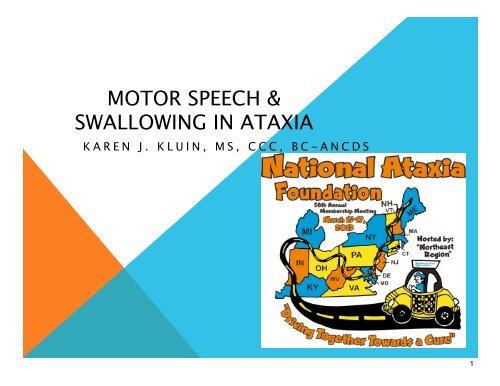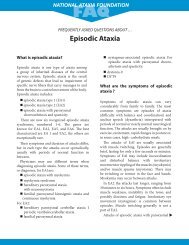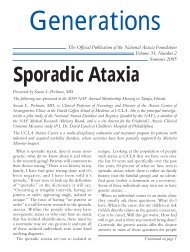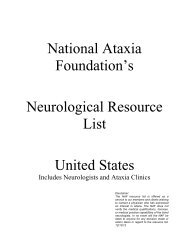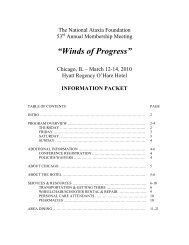Strategies to improve Speech & Swallowing in Ataxia
Strategies to improve Speech & Swallowing in Ataxia
Strategies to improve Speech & Swallowing in Ataxia
Create successful ePaper yourself
Turn your PDF publications into a flip-book with our unique Google optimized e-Paper software.
MOTOR SPEECH &<br />
SWALLOWING IN ATAXIA<br />
KAREN J. KLUIN, MS, CCC, BC-ANCDS<br />
1
DISCLAIMER<br />
The <strong>in</strong>formation provided by speakers <strong>in</strong> any presentation made as<br />
part of the 2013 NAF Annual Membership Meet<strong>in</strong>g is for<br />
<strong>in</strong>formational use only.<br />
NAF encourages all attendees <strong>to</strong> consult with their primary care<br />
provider, neurologist, or other health care provider about any advice,<br />
exercise, therapies, medication, treatment, nutritional supplement, or<br />
regimen that may have been mentioned as part of any presentation.<br />
Products or services mentioned dur<strong>in</strong>g these presentations does not<br />
imply endorsement by NAF.<br />
2
PRESENTER DISCLOSURES<br />
Karen Klu<strong>in</strong>, MS, CCC, BC-ANCDS<br />
No relationships <strong>to</strong> disclose or list<br />
3
COMMUNICATION<br />
Dependent on the smooth sequenc<strong>in</strong>g:<br />
1. Mo<strong>to</strong>r<br />
2. Programm<strong>in</strong>g & sequenc<strong>in</strong>g <strong>in</strong><br />
voluntary production<br />
3. Language<br />
4. Thought/Cognition & Memory<br />
4
BREAKDOWN RESULTS IN DISTINCT<br />
COMMUNICATION DISORDERS<br />
1. DYSARTHRIA<br />
2. VERBAL APRAXIA/APRAXIA OF<br />
SPEECH<br />
3. APHASIA/DYSPHASIA<br />
4. LANGUAGE OF GENERALIZED<br />
INTELLECTUAL IMPAIRMENT<br />
5
NORMAL MOTOR SPEECH<br />
Requires rapid & smooth f<strong>in</strong>e mo<strong>to</strong>r movements of<br />
the speech mechanism:<br />
• Head/Neck<br />
• Face & Lips<br />
• Jaw<br />
• Tongue<br />
• Palatal-Pharyngeal<br />
• Respira<strong>to</strong>ry<br />
6
NORMAL MOTOR SPEECH<br />
Involves the mo<strong>to</strong>r speech processes of:<br />
•Breath<strong>in</strong>g (Respiration)<br />
•Voic<strong>in</strong>g (Phonation)<br />
•Pronunciation (Articulation)<br />
•Melody or rate of speak<strong>in</strong>g & stress<br />
patterns (Prosody)<br />
7
DYSARTHRIA<br />
Mo<strong>to</strong>r speech disorder due <strong>to</strong> central nervous<br />
system or peripheral system dysfunction<br />
result<strong>in</strong>g <strong>in</strong> slowness, weakness,<br />
<strong>in</strong>coord<strong>in</strong>ation or change <strong>in</strong> <strong>to</strong>ne of the speech<br />
musculature<br />
Includes disorders of respiration, voice,<br />
resonance, articulation, and prosody of<br />
8
MOTOR SPEECH EVALUATION<br />
•Cranial Nerve/Oral Mo<strong>to</strong>r Exam<br />
•Oral Diadochok<strong>in</strong>etic Rates of<br />
PA, TA, KA, PATAKA<br />
•Perceptual <strong>Speech</strong> Analysis<br />
9
ATAXIA<br />
Disturbances <strong>in</strong> the tim<strong>in</strong>g, speed,<br />
force, range & direction of motion<br />
of the speech mechanism & mo<strong>to</strong>r<br />
speech processes results <strong>in</strong> an<br />
ATAXIC DYSARTHRIA.<br />
10
ATAXIC DEVIANT SPEECH<br />
DIMENSIONS<br />
• Excess and Equal Stress<br />
• Irregular Articula<strong>to</strong>ry Breakdown<br />
• Alternat<strong>in</strong>g Loudness Variation<br />
• Fluctuat<strong>in</strong>g Pitch Levels<br />
• Variable Rate<br />
• Harsh Voice – Transient<br />
• Breathy Voice – Transient<br />
• Altered Nasality – Transient<br />
• Voice Tremors<br />
• Audible Inspiration<br />
11
COMMON DEVIANT SPEECH<br />
DIMENSIONS IN ATAXIC<br />
• Respiration: Audible <strong>in</strong>spirations<br />
• Phonation: Fluctuat<strong>in</strong>g pitch levels;<br />
alternat<strong>in</strong>g loudness variation;<br />
transient harsh quality; transient<br />
breathy quality; voice tremors<br />
12
COMMON DEVIANT SPEECH<br />
DIMENSIONS IN ATAXIC DYSARTHRIA<br />
Resonance: Transient hypernasality;<br />
transient hyponasality<br />
Articulation: Irregular articula<strong>to</strong>ry<br />
breakdown<br />
13
COMMON DEVIANT SPEECH<br />
Prosody: Variable speak<strong>in</strong>g rate, excess &<br />
equal stress patterns<br />
14
DYSARTHRIA TREATMENT<br />
Goal: To <strong>improve</strong> the clarity of<br />
speech via compensa<strong>to</strong>ry<br />
strategies<br />
15
COMPENSATORY DYSARTHRIA<br />
• Sit upright.<br />
• Take a breath of air <strong>in</strong> prior <strong>to</strong> speak<strong>in</strong>g.<br />
• Speak slowly.<br />
• Pause frequently. Limit the number of<br />
words you say per breath.<br />
• Say all the sounds <strong>in</strong> the words,<br />
especially the f<strong>in</strong>al sounds of the word<br />
16
Dependent upon rapid neuromuscular<br />
coord<strong>in</strong>ation of the structures and<br />
muscles <strong>in</strong> the:<br />
• Mouth/Oral Cavity<br />
• Throat/Pharynx<br />
• Voice Box/Larynx<br />
17
ANATOMY<br />
18
SWALLOWING<br />
Divided <strong>in</strong> 3 phases:<br />
• Oral Prepara<strong>to</strong>ry & Oral<br />
• Pharyngeal<br />
• Esophageal<br />
19
ORAL PREPARATORY<br />
Eat<strong>in</strong>g is anticipated<br />
Food is brought <strong>to</strong> the mouth<br />
Bitten off<br />
Taken from the utensil<br />
Food is chewed and mixed with saliva<br />
Liquids are sipped or sucked through a straw<br />
©ASHA<br />
20
ORAL PHASE<br />
The food is collected<br />
Sealed between the roof of the mouth and<br />
the <strong>to</strong>ngue<br />
The <strong>to</strong>ngue moves the food back with a<br />
stripp<strong>in</strong>g wave <strong>in</strong><strong>to</strong> the back of the<br />
throat (pharynx)<br />
This beg<strong>in</strong>s the actual swallow<br />
21
PHARYNGEAL PHASE<br />
Soft palate elevates<br />
Prevent<strong>in</strong>g food from escap<strong>in</strong>g <strong>in</strong><strong>to</strong> the nose<br />
Tongue base moves back <strong>to</strong> contact<br />
pharyngeal wall<br />
Larynx (voice box) moves up and forward<br />
Epiglottis (<strong>to</strong>p part of larynx) is tilted down<br />
and back <strong>to</strong> guide the food past the<br />
airway<br />
23
PHARYNGEAL PHASE<br />
Breath<strong>in</strong>g momentarily s<strong>to</strong>ps<br />
Vocal folds come <strong>to</strong>gether <strong>to</strong> further<br />
protect airway<br />
Muscles of the pharynx contract<br />
Move the food <strong>to</strong>wards the esophagus (tube<br />
lead<strong>in</strong>g <strong>to</strong> s<strong>to</strong>mach)<br />
Upper esophageal sph<strong>in</strong>cter relaxes<br />
Food passes <strong>in</strong><strong>to</strong> the esophagus<br />
©ASHA<br />
25
ESOPHAGEAL PHASE<br />
Peristalsis (a wave of contraction) moves the<br />
food through the esophagus<br />
The lower esophageal sph<strong>in</strong>cter relaxes <strong>to</strong><br />
allow the food <strong>to</strong> pass <strong>in</strong><strong>to</strong> the s<strong>to</strong>mach<br />
©ASHA<br />
27
WHAT IS DYSPHAGIA?<br />
Difficulty with eat<strong>in</strong>g which may <strong>in</strong>clude one<br />
or more of the follow<strong>in</strong>g<br />
Chew<strong>in</strong>g food<br />
<strong>Swallow<strong>in</strong>g</strong> solids and/or liquids<br />
Cough<strong>in</strong>g or chok<strong>in</strong>g when eat<strong>in</strong>g<br />
Food stick<strong>in</strong>g <strong>in</strong> the throat or chest<br />
It is estimated that more than 15 million<br />
people <strong>in</strong> the United States have Dysphagia<br />
©ASHA<br />
28
ATAXIA<br />
Disturbances <strong>in</strong>:<br />
• Tim<strong>in</strong>g & Speed<br />
• Force<br />
• Range of motion<br />
• Direction of motion<br />
can result <strong>in</strong> an abnormal swallow or<br />
DYSPHAGIA<br />
29
ORAL PHASE<br />
• Loss of bolus control especially of large<br />
sizes due <strong>to</strong> disorganized anterior <strong>to</strong><br />
posterior <strong>to</strong>ngue movements with<br />
portions fall<strong>in</strong>g <strong>in</strong><strong>to</strong> throat before<br />
ready <strong>to</strong> swallow<br />
• Bit<strong>in</strong>g <strong>to</strong>ngue or sides of mouth due <strong>to</strong><br />
discoord<strong>in</strong>ation<br />
• Dim<strong>in</strong>ished chew<strong>in</strong>g of solids<br />
30
PHARYNGEAL PHASE SYMPTOMS<br />
• Sensation of food stuck <strong>in</strong> throat<br />
after the swallow due <strong>to</strong> not<br />
chew<strong>in</strong>g solids well<br />
• Episodes of cough<strong>in</strong>g when<br />
eat<strong>in</strong>g/dr<strong>in</strong>k<strong>in</strong>g <strong>to</strong>o quickly<br />
31
SWALLOWING GOAL<br />
Facilitate safe swallow<strong>in</strong>g via use of<br />
basic swallow<strong>in</strong>g suggestions or if<br />
needed compensa<strong>to</strong>ry strategies<br />
and/or modification of diet.<br />
34
BASIC SWALLOWING SUGGESTIONS<br />
• Sit upright.<br />
• Br<strong>in</strong>g liquid/solid up <strong>to</strong> mouth.<br />
• Take smaller sips/bites.<br />
• Dr<strong>in</strong>k/eat more slowly.<br />
35
BASIC SWALLOWING<br />
• Swallow everyth<strong>in</strong>g <strong>in</strong> mouth prior <strong>to</strong><br />
the next bite or sip.<br />
• Alternate swallows of liquids & solids.<br />
• Do not try <strong>to</strong> talk and swallow at the<br />
same time.<br />
36
• Individualized recommendations based upon<br />
evaluation by a certified speech<br />
pathologist <strong>to</strong> address <strong>in</strong>dividual mo<strong>to</strong>r<br />
speech and swallow<strong>in</strong>g needs.<br />
• Carry card with neurologic disorder &<br />
symp<strong>to</strong>ms such as speech, balance,<br />
walk<strong>in</strong>g problems with contact <strong>in</strong>formation<br />
for emergency situations.<br />
37
MOTOR SPEECH &<br />
KAREN J. KLUIN, MS, CCC, BC-<br />
ANCDS<br />
SPEECH-LANGUAGE PATHOLOGY<br />
UNIVERSITY OF MICHIGAN<br />
38


